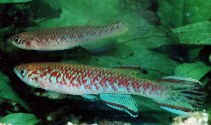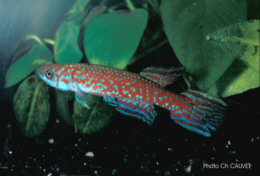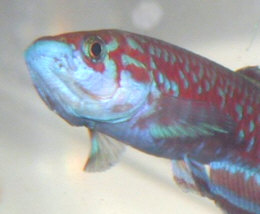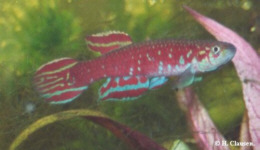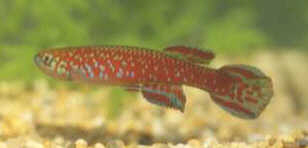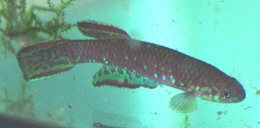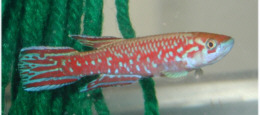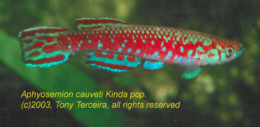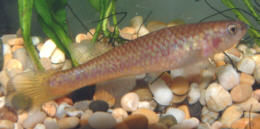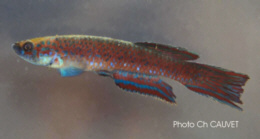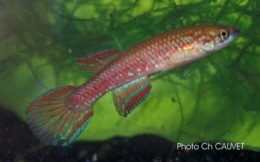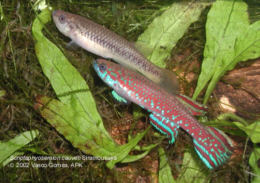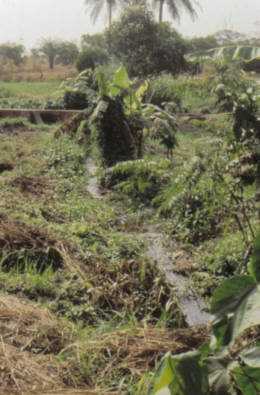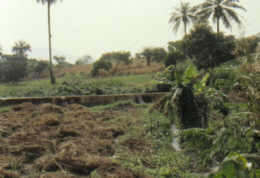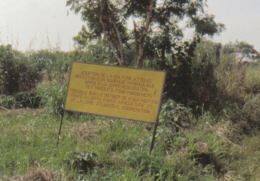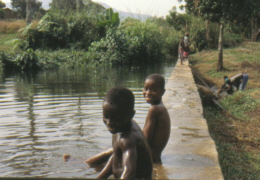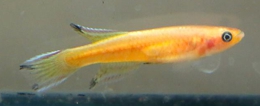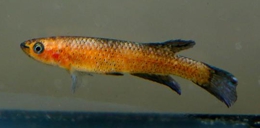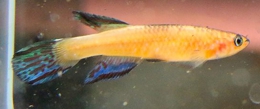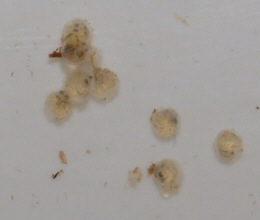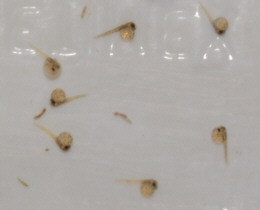Scriptaphyosemion cauveti (Romand & Ozouf 1995)
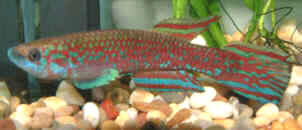
Scriptaphyosemion
cauveti Kindia.
Photo courtesy of Richard
Cox
| Meaning of Name |
After Christian Cauvet, French aquarist & collector. | |||||||||||||||||||
| First Description |
Romand.
R. & Ozouf C, Costaz 1995. | |||||||||||||||||||
| Size |
7 cm | |||||||||||||||||||
| Meristics |
D=13, A=16·9, D/A=6·6, ll=34·4 (Huber - Killie Data)(You will need to be registered at this site to open this link). | |||||||||||||||||||
| Karyotype |
n=18, A=20 (Huber - Killie Data). | |||||||||||||||||||
| Sub-Genus |
. | |||||||||||||||||||
| Group |
. | |||||||||||||||||||
| Synonyms |
| |||||||||||||||||||
Populations
|
Barrage de la Loire Atlantique
- GRCH 93 / 239 - Situated about 3 kms past the Siramousaya location
towards Kindia on the right side of the road. A small pool (called
Barrage = dam) behind a low retaining wall used by children for swimming.
This drained into a small stream with spongy banks in direct sunlight.
Terrestrial plants edged this stream. Cauvet in 1993 collected about
30 fish from this location.
CI 6 / 93 - Alan Green found these in a commercial shipment & brought them round to me for breeding. These were easily bred & eggs distributed. In Scandinavia these were still going well for many years after.
Etz - Circulated in the USA as A.sp.Etz. Known to be still there in 2002. It is reputed to be a very shy fish.
GRCH 93 / 5 - Most likely a corrupted code by a typing error. Imported into the USA & still going strong in 2003.
Kindia -
| |||||||||||||||||||
| Type Locality |
Loire Atlantique, 8 km after the town of Kindia on the road to Télimélé. Preserved material kept at the Natural History Museum Paris. | |||||||||||||||||||
| Distribution |
Foothills of the
northern Guinee plateau. Occupies an area between S.geryi
in the west & S.guignardi to
the east. Distribution is likely to be restricted to the upper Santa
drainage. | |||||||||||||||||||
| Habitat |
The Kindia location is 455 metres above sea level. Christian Cauvet collected this sp. in clear water with a flow & a high temperature. Water depth recorded at 30 cm. Water temperature recorded as being between 20 - 28°C. Christian Cauvet sent me this information - 'During my 3 collecting trips for Roloffia, collecting places 238 and 239 were the only ones where I could catch quantities of wild adult Scriptaphyosemion. Scriptaphyosemion you can catch are mostly young fish, and very few fully developed as cauveti were. This was true whatever the season : I collected in November in SL and Guinea and in April in Guinea ( this is not true with Callopanchax...you can get big fish in November)'. | |||||||||||||||||||
| Distinguishing Characteristics | A species with a lot of red/purple colouration on the body. Quite easy to seperate from Script.geryi. Females can show a line of brown spots horizontally through the centre of the body. | |||||||||||||||||||
| Colour/Pattern Variability | Fairly low. Some males can show an almost solid red on the body. | |||||||||||||||||||
| History |
In 1991 André Lambert (then secretary of the KCF) gave Christian Cauvet fish caught in a stream near Kindia. Cauvet bred the fish & sent fish & photographs to Romand. Raymond Romand was asked for an opinion &
considered they may be a new species but hesitated to do a description
as he had not seen live fish & the photos were of young fish. The
area of this collection was vague & reported as a stream on the
road from Kindia to Telimele. Collected by Ch.
Cauvet, J.M. Hervieux and R.Romand in November 1993 in 2 locations (Siramousaya
& Barrage de la Loire Atlantique. Prior to this collection they
were known as undescribed sp. in imports in England & Germany from
a commercial collector in Guinea. The following is an extract from a paper by Romand and Ozouf-Costaz (Cybium, 1995, 19(4), 391-400) who first described A. cauveti as a new species. Unfortunately no information about water conditions in the paper. "The holotype (adult male) and allotype (adult female) were collected from a small brook after a small dam (the "Loire Atlantique") 8 km after the town of Kindia on the road to Télimélé. The paratypes comprise 8 specimens from the same locality as the holotype and 5 specimens from a small brook 11 km after the town of Kindia on the road to Télimélé, close to the village of Siramousaya". Alan Green found some in a commercial import
in 1993 & gave me some pairs. As it was something new I called them
Roloffia geryi CI 93/6. These were
bred & fish/eggs were distributed. I sent a photo to Eckard Busch
who thought they were a red form of geryi. | |||||||||||||||||||
| Breeding Notes |
Wright Huntley of the AKA kindly filled in the
breeding box regarding breeding information on this sp. Cauvet bred his original fish using the natural method of leaving them to it in a well planted tank. Both adults & larger fry are cannilalistic so not too many fish can be raised this way. Higher temperatures were found to be better at 25°C. Fish will start to spawn at 20°C but are not so prolific. I had fish up to F3 no problem. I did have a pure golden male apart from pale blue outer margins in the unpaired fins.
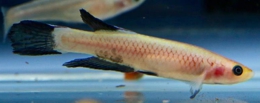 | |||||||||||||||||||
| Diameter of Egg |
Eggs are larger than Script.geryi. |
|||||||||||||||||||
| Remarks |
Christian Cauvet reported in BKA newsletter No.455,
August 2003 that Epiplatys were
absent in the wild collection places. He experimented in aquaria with
keeping them with E.njalaensis &
found they did not tolerate them & 'literally massacred them'. This
could be the reason no Epiplatys
were found as a sympatric species. It has been noted that another breeder raised A.pascheni festivum with cauveti without any aggression on the part of cauveti. They were raised in a 4' tank with Cardinal Tetra. |
